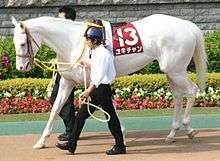White horse
White horses are born white and stay white throughout their lives. White horses may have brown, blue, or hazel eyes. "True white" horses, especially those that carry one of the dominant white (W) genes, are rare. Most horses that are commonly referred to as "white" are actually "gray" horses whose hair coats are completely white and may be born of any color and gradually "gray" as time goes on and take on a white appearance.[1]
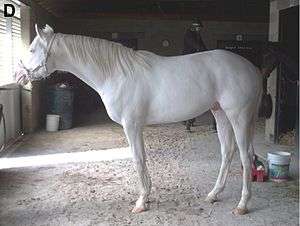
True white horses
White horses have unpigmented skin and a white hair coat. Many white horses have dark eyes, though some have blue eyes. In contrast to gray horses which are born with pigmented skin they keep for life and pigmented hair that lightens to white with age, truly white horses are born with white hair and mostly pink, unpigmented skin. Some white horses are born with partial pigmentation in their skin and hair, which may or may not be retained as they mature, but when a white horse lightens, both skin and hair lose pigmentation. In contrast, grays retain skin pigment and only the hair becomes white.
White colorings, whether white markings, white patterns or dominant white are collectively known as depigmentation phenotypes, and are all caused by areas of skin that lack pigment cells (melanocytes).[2] Depigmentation phenotypes have various genetic causes, and those that have been studied usually map to the EDNRB and KIT genes. However, much about the genetics behind various all-white depigmentation phenotypes are still unknown.
Dominant white
Dominant white is best known for producing pink-skinned all-white horses with brown eyes, though some dominant white horses have residual pigment along the topline. Dominant white has been studied in Thoroughbreds, Arabian horses, the American White horse, the Camarillo White Horse, and several other breeds. There are 27 identified variants of dominant white as of 2017, plus sabino 1, each corresponding to a spontaneously-white foundation animal and a mutation on the KIT gene. Researchers have suggested that at least some forms of dominant white result in nonviable embryos in the homozygous state, though others are known to be viable as homozygotes. While homologous mutations in mice are often linked to anemia and sterility, no such effects have been observed in dominant white horses. Dominant white horses typically have white noses that can be subject to sunburn.
Sabino-white
Sabino-white horses are pink-skinned with all-white or nearly-white coats and dark eyes. They are homozygous for the dominant SB1 allele at the Sabino 1 locus, which has been mapped to KIT.[5] Without a DNA test, Sabino-white horses are indistinguishable from dominant white horses. The Sabino1 allele, and the associated spotting pattern, is found in Miniature horses, American Quarter Horses, American Paint Horses, Tennessee Walkers, Missouri Fox Trotters, Mustangs, Shetland Ponies, and Aztecas.[6] Sabino 1 has not been found in the Arabian horse, Clydesdale,[5] Thoroughbred, Standardbred horse, or Shire horse. The Sabino 1 allele is not linked to any health defects, though sabino-whites may need some protection from sunburn. Horses with only one copy of the Sabino1 gene usually have dramatic spotting, including two or more white legs, often with white running up the front of the leg, extensive white on the face, spotting on the midsection, and jagged or roaned margins to the pattern.[5]
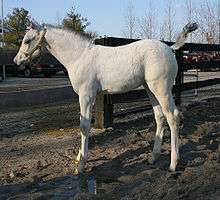
White born leopards
The leopard complex, related to the Leopard (LP) gene, characterizes the Appaloosa and Knabstrupper breeds with their spotted coats. Leopard is genetically quite distinct from all other white and white-spotting patterns. The fewspot leopard pattern, however, can resemble white. Two factors influence the eventual appearance of a leopard complex coat: whether one copy (heterozygous LP/lp) or two copies (homozygous LP/LP) Leopard alleles are present, and the degree of dense white patterning present at birth.[7] If a foal is homozygous for the LP allele and has extensive dense white patterning, they will appear nearly white at birth, and may continue to lighten with age. In other parts of the world, these horses are called "white born."[8] "White born" foals are less common among Appaloosa horses than Knabstruppers or Norikers, as the extensive dense white patterning is favored for producing dramatic full leopards. Homozygous leopards have the LP/LP genotype, and may be varnish roan, fewspot leopard, or snowcap patterned. Homozygous leopards are substantially more prone to congenital stationary night blindness.[9] Congenital stationary night blindness is present at birth and is characterized by impaired vision in dark conditions.
Lethal white syndrome
Lethal white syndrome is a genetic disorder linked to the Frame overo (O) gene and most closely studied in the American Paint Horse. Affected foals are carried to term and at birth appear normal, though they have pink-skinned all-white or nearly-white coats and blue eyes. However, the colon of these foals cannot function due to the absence of nerve cells, and the condition cannot be treated. Foals with Lethal White Syndrome invariably die of colic within 72 hours, and are usually humanely euthanized. Carriers of the gene, who are healthy and normal, can be identified by a DNA test. While carriers often exhibit the "frame overo" pattern, this is not a dispositive trait and testing is necessary, as the pattern can appear in a minimal form as normal white markings or be masked by other white spotting genes.
Horses that appear white, but are not
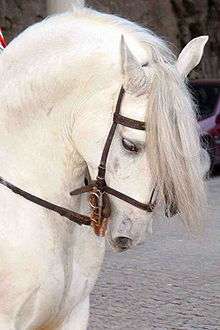
True white horses have unpigmented pink skin and unpigmented white hair, though eye color varies. The lack of pigment in the skin and hair is caused by the absence of pigment-producing cells called melanocytes. Some coat colors are characterized by light or white-like coats and even pinkish skin, however these white-like coats are not lacking melanocytes. Instead, white-like coat colors result from various changes in the ways melanocytes produce pigment.
Gray
Gray horses have the most common "white-like" coat color. However, the most noticeable difference between a gray horse whose hair coat is completely white and a white horse is skin color: most gray horses have black skin and dark eyes, white horses have light, unpigmented skin. The gray gene does not affect skin or eye color, so grays typically have dark skin and eyes, as opposed to the unpigmented pink skin of true white horses.[10] The skin and eyes may be other colors if influenced by other factors such as white markings, certain white spotting patterns or dilution genes. Gray foals may be born any color, but the colored hairs of their coat become progressively silvered as they age, eventually giving mature gray horses a white or nearly-white hair coat. Gray is controlled by a single dominant allele of a gene that regulates specific kinds of stem cells.[11] Gray horses are at an increased risk for melanoma; 70-80% of gray horses over the age of 15 have a melanoma tumor.[11]
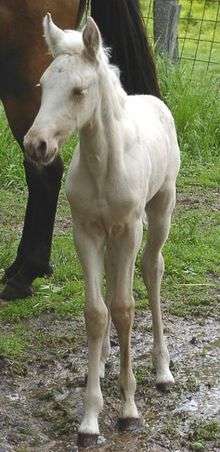
Diluted coat colors
True white hair is rooted in unpigmented skin that lacks melanocytes. In contrast, diluted coat colors have melanocytes, but vary due to the concentration or chemical structure of the pigments made by these pigment-producing cells, not the absence of the cells themselves. There are at least five known types of pigment dilution in horses, three which, as described below, can act to produce off-white phenotypes. Horses with strongly diluted coat colors usually have pale blue eyes, cream-colored coats, and rosy-pink skin. White markings are usually visible upon closer inspection.
- The Cream gene produces two types of diluted color. Cremellos, perlinos, and smoky creams have rosy-pink skin, pale blue eyes, and cream-colored coats that can appear almost white. These coat colors, collectively called "double dilutes" or "blue-eyed creams", result when a horse is homozygous for the cream gene. When heterozygous, the cream gene is also responsible for palomino and buckskin. A few Palominos have a very light hair coat is occasionally mistaken for either cremello or white. White markings and patterns are visible against the slightly-pigmented coat and skin. The cream gene is not known to be associated with any health problems.
- Pearl-Cream pseudo-double dilute occurs when a horse has one cream gene and one pearl gene. These two distinct dilution factors interact to produce a cremello-like coat. Pearl-creams have pale but pigmented skin and blue-green eyes, and are distinctly pale cream-colored.[12] To date, the Pearl gene has been found in Quarter Horses, Paint horses, and some Iberian horses.[13] Pearl is not known to be associated with any health problems.
- Champagne-Cream pseudo-double dilute occurs when a horse has one cream gene and one champagne gene. Champagne and cream are another pair of unrelated dilution factors that interact to produce a cremello-like coat. Champagne-creams have freckled, pinkish skin, pale eyes, and pale coats. These colors were formerly referred to as "ivory champagnes".[14] Champagne is found in North American breeds such as the American Cream Draft, Tennessee Walking Horse, American Saddlebred, American Quarter Horse, and Miniature horse. It is not known to be associated with any health problems.
Albinism
Although white horses are sometimes called "albino" there are no reported cases of a true "albino" horse.[15] There are also references in literature calling white horses "albino".[16] Dominant white in horses is caused by the absence of pigment cells (melanocytes), whereas albino animals have a normal distribution of melanocytes.[17] In other animals, patches of unpigmented skin, hair, or eyes due to the lack of pigment cells (melanocytes) are called piebaldism, not albinism nor partial albinism.
All so-called "albino" horses have pigmented eyes, generally brown or blue. In contrast, many albino mammals, such as mice or rabbits, typically have a white hair coat, unpigmented skin and reddish eyes. The definition of "albinism" varies depending on whether humans, other mammals, or other vertebrates are being discussed.[18]
Despite this, some registries still refer to "albino" horses. For example, the Paso Fino Horse Association registers cremellos and other cream colors as "albino."[19] Until 1999, the American Quarter Horse Association (AQHA) described perlino or cremello horses as "albino" in rule 227(j).[20] The AQHA later replaced the word "albino" with "cremello or perlino," and in 2002 the rule was removed entirely. Among Connemara pony breeders, homozygous creams are called "blue-eyed creams" or sometimes "pseudo-albino".[21]
Types of albinism in humans and other animals
The best-known type of albinism is OCA1A, which impairs tyrosinase production. In other mammals, the diagnosis of albinism is based on the impairment of tyrosinase production through defects in the Color (C) gene.[22] Mice and other mammals without tyrosinase have unpigmented pink skin, unpigmented white hair, unpigmented reddish eyes, and some form of vision impairment. No mutations of the tyrosinase or C gene are known in horses.[15]
Humans exhibit a wide range of pigmentation levels as a species. However, the diagnosis of albinism in humans is based on visual impairment, which has not been described in white horses.[23] Vision problems are not associated with gray, dilute, or white coat colors in horses, and blue eyes in horses do not indicate poor vision. Eyes are pigmented at the front of the iris called the stroma, and in a thin layer at the back of the iris in tissue called the iris pigment epithelium. The iris pigment epithelium prevents damaging light scattering within the eye. Blue-eyed humans and mammals have little or no pigment in the stroma, but retain pigment in the iris pigment epithelium. If pigment is missing from both the stroma and the iris pigment epithelium, the only pigment in the eye is the hemoglobin in blood vessels. This accounts for the reddish appearance of eyes in some types of albinism.[24]
In research mammals, such as mice, albinism is more strictly defined. Albino mice occur due to a recessive mutation of the C gene. No such mutation exists in horses.[15] Albino mice lack pigment, but "...the inability of albino animals to produce pigment stems not from an absence of melanocytes...but from a deficiency and/or alteration of the structure of tyrosinase in melanocytes which are otherwise normal."[17] This definition of albinism in mice – the inability to make tyrosinase – is extended to other mammals.[22]
While mammals derive their pigments only from melanins, fish, reptiles and birds rely on a number of pigments apart from melanins: carotenoids, porphyrins, psittacofulvins, pterins, etc.[18][25] Most commonly, reptiles with a condition homologous to human OCA1A retain their reddish and orangish hues. As a result, birds and reptiles without the ability to manufacture tyrosinase are more accurately described as "amelanistic." Horses do not have non-melanin pigments and so if they were albino, would have no pigmentation. The retained pigment of dilute horses, like cremellos, is not comparable to the retained pigment of amelanistic "albino" birds and reptiles.
Why cream is not albino
The cream gene, which is responsible for palomino, buckskin, and cremello coat colors, was mapped to the MATP gene in 2003.[26] This gene is sometimes called the OCA4 gene, because one mutation on MATP is associated with Oculocutaneous albinism type 4. However, other benign mutations on MATP are responsible for normal variations in skin, hair, and eye color in humans.[27] MATP is not the "albino gene"; one of many mutations of the human MATP is responsible for a form of albinism.
Famous white horses
Many famous horses, past and present, were alleged to be "white" by observers, but were actually grays with hair coats turned fully white. Likewise, most white horses used in movies are actually grays, in part because they are easier to find.
However, there are a few truly white horses who were used in film. One of the best-known examples was "Silver," ridden by the Lone Ranger, a role actually played by two different white horses. At least one horse who played "Topper," ridden by Hopalong Cassidy, was also white. Another famous white horse is Yukichan, a Japanese Thoroughbred racehorse who won the Kanto Oaks at Kawasaki Racecourse.[28]
Mythology
Throughout history, white horses have been mythologized in many cultures. For example, Herodotus reported that white horses were held as sacred animals in the Achaemenid court of Xerxes the Great (ruled 486–465 BC),[29] In more than one tradition, a white horse carries patron saints or the world saviour in the end times, including Hinduism, Christianity, and Islam.
See also
References
- "Introduction to Coat Color Genetics" from Veterinary Genetics Laboratory, School of Veterinary Medicine, University of California, Davis. Web Site accessed January 12, 2008
- Rieder, Stefan; Christian Hagger; Gabriela Obexer-Ruff; Tosso Leeb; Pierre-André Poncet (2 February 2008). "Genetic Analysis of White Facial and Leg Markings in the Swiss Franches-Montagnes Horse Breed". Journal of Heredity. The American Genetic Association. 99 (2): 130–6. doi:10.1093/jhered/esm115. PMID 18296388. Retrieved 3 July 2009.
Phenotypes may vary from tiny depigmentated body spots to white head and leg markings, further on to large white spotting and finally nearly complete depigmentation in white-born horses...White markings result from the lack of melanocytes in the hair follicles and the skin...A completely pigmented head or leg depends on the complete migration and clonal proliferation of the melanoblasts in the mesoderm of the developing fetus, thus ensuring that limbs and the head acquire a full complement of melanocytes
- Kathman, Lesli(2014). "The Equine Tapestry", p. 83, 90–94. Blackberry Lane Press.
- "YUCHICHAN".
- UC Davis. "Horse Coat Color Tests". Veterinary Genetics Laboratory. University of California – Davis. Retrieved 8 July 2009.
Horses with 2 copies of the Sabino1 gene, are at least 90% white and are referred to as Sabino-white.
- Brooks, Samantha (2005). "The SNP was found among American Miniature Horses, American Paint Horses, Azteca, Missouri Fox Trotters, Shetland Ponies, and Spanish Mustangs."
- Sheila Archer (3 August 2008). "Studies Currently Underway". The Appaloosa Project. Retrieved 4 November 2008.
- "Die Farbmerkmale" (in German). Knabstrupper.de. Retrieved 20 June 2009.
- Sandmeyer, Lynne S.; Carrie B. Breaux; Sheila Archer; Bruce H. Grahn (2007). "CSNB and Leopard Complex in Appaloosas". 10 (6). American College of Veterinary Ophthalmologists: 368–375. doi:10.1111/j.1463-5224.2007.00572.x. PMID 17970998. Cite journal requires
|journal=(help) - Locke, MM; MCT Penedo; SJ Bricker; LV Millon; JD Murray (2002). "Linkage of the grey coat colour locus to microsatellites on horse chromosome 25". Animal Genetics. International Society for Animal Genetics. 33 (5): 329–337. doi:10.1046/j.1365-2052.2002.00885.x. PMID 12354140.
The progressive loss of colour in the hair of grey horses is controlled by a dominantly inherited allele at the Grey locus (GG). Foals are born any colour depending on the alleles present at other colour determining loci. After birth, horses carrying the GG allele begin to show white hairs that are intermixed with their original hair colour. Although the rate at which horses will turn grey is variable, the amount of white hair increases with age until the coat is completely white at maturity. Pigmentation of the skin and eyes is not affected by GG. Dark skin distinguishes the grey phenotype from that of pink-skinned cremello and white horses.
- Pielberg, Gerli Rosengren; Anna Golovko; Elisabeth Sundström; Ino Curik; Johan Lennartsson; Monika H Seltenhammer; Thomas Druml; Matthew Binns; Carolyn Fitzsimmons; Gabriella Lindgren; Kaj Sandberg; Roswitha Baumung; Monika Vetterlein; Sara Strömberg; Manfred Grabherr; Claire Wade; Kerstin Lindblad-Toh; Fredrik Pontén; Carl-Henrik Heldin; Johann Sölkner; Leif Andersson (2008). "A cis-acting regulatory mutation causes premature hair graying and susceptibility to melanoma in the horse". Nature Genetics. 40 (8): 1004–1009. doi:10.1038/ng.185. PMID 18641652.
- UC Davis. "Horse Coat Color Tests". Veterinary Genetics Laboratory. University of California – Davis. Retrieved 11 January 2008.
Pearl is known to interact with Cream dilution to produce pseudo-double Cream dilute phenotypes including pale skin and blue/green eyes.
- Stamatelakys, Irene (May 2009). "Precious Pearls" (PDF). Paint Horse Journal.
- "Champagne-Cream Combinations". International Champagne Horse Registry. Retrieved 4 June 2009.
- Castle, William E (1948). "The ABC of Color Inheritance in Horses". Genetics. 33 (1): 22–35. PMC 1209395. PMID 17247268.
No true albino mutation of the color gene is known among horses, though several varieties of white horse are popularly known as albinos.
- O'Hara, Mary (1941). My Friend Flicka. Lippincott.
- Silvers, Willys K. (1979). "3: The b-Locus and c (Albino) Series of Alleles". The Coat Colors of Mice: A Model for Mammalian Gene Action and Interaction. Springer Verlag. p. 59. Retrieved 7 July 2009.
...the inability of albino animals to produce pigment stems not from an absence of melanocytes
- Davis, Jeff (September–October 2007). "Color Abnormalities in Birds: A Proposed Nomenclature". Birding. American Birding Association. 39 (5).
- "Registration Application" (PDF). Paso Fino Horse Association. Retrieved 4 July 2009.
- "No horse is eligible for registration which possesses all three characteristics which designate a horse commonly known as an albino: light (or pink) skin over the body; white or cream colored hair over the body; and eyes of a bluish cast."
- Jeanette Gower (December 2002). "The Blue Eyed Cream Pony: Flawed or Value?" (PDF). Connemara Pony Breeders Society of Australia.
- Cheville, Norman F (August 2006). Introduction to veterinary pathology (3 ed.). Wiley-Blackwell. ISBN 978-0-8138-2495-6.
Albinism results from a structural gene mutation at the locus that codes for tyrosinase; that is, albino animals have a genetically determined failure of tyrosine synthesis.
- "What is Albinism?". The National Organization for Albinism and Hypopigmentation. Archived from the original on 14 May 2012. Retrieved 7 July 2009.
- Hamilton, Peter; Richard Gregson; Gary Edd Fish (1997). Text Atlas of the Retina (1 ed.). Informa Health Care. p. 151. ISBN 1-85317-226-X.
In the most severe form, the latter may look pink since the only pigment present is hemoglobin within the iris blood vessels
- "Chromatophores". Learning Center. VMS. Retrieved 7 July 2009.
- Mariat, Denis; Sead Taourit; Gérard Guérin (2003). "A mutation in the MATP gene causes the cream coat colour in the horse". Genet. Sel. Evol. INRA, EDP Sciences. 35 (1): 119–133. doi:10.1051/gse:2002039. PMC 2732686. PMID 12605854.
- Graf, J; Voisey J; Hughes I; van Daal A (July 2007). "Promoter polymorphisms in the MATP (SLC45A2) gene are associated with normal human skin color variation". Human Mutation. Wiley-Liss. 28 (7): 710–7. doi:10.1002/humu.20504. PMID 17358008.
- Yukichan horse pedigreequery
- "White Horses and Genetics". Archaeology.about.com. Retrieved 29 April 2010.
| Wikimedia Commons has media related to White horses. |
